Pathways from ultrafast light to cold magnetic storage
In the last time light provides an ultrafast and energy-efficient way to transfer digital data in optical networks, magnetism facilitates the cheapest and the most reliable memory. These unique qualities naturally triggered intense search for materials and fundamental studies of mechanisms allowing writing magnetic information solely with the help of light. Recent our discovery, which was published in Nature’2017 [1], revealed a possibility of fastest magnetic recording with a single ultrafast laser pulse on a transparent garnet without relying on heat. This result naturally raised question about selection rules, i.e. the optimal wavelength, the polarization and the intensity of light, for such a recording.
Andrzej Stupakiewicz from University of Bialystok and colleagues from Nijmegen and Moscow demonstrated novel pathways in their publication in Nature Communications [2] how Co ions with different symmetry (either tetrahedral or octahedral) in iron garnet crystal, allows the magnetization of selected cell can be switched. This switching can lead to a magnetic recording different cells by tunable combination of optical parameters of femtosecond laser single and multiple pulses at near-infrared range. Such precisely directed impact has the potential to provide novel possibilities for cold magnetic storage and ultrafast transfer of recorded data using of ultrashort light pulses in the optical telecommunication systems.
The discovered selection rules allowed us to reveal the origin of the photo-magnetic centers and thus to perform quantitative estimates of the efficiency of photo-magnetic recording. It means that even single-photon excitation of Co ion must be, in principle, sufficient to control the magnetic cell of 28 nm3 (in terabyte HDD storage the volume of single bit is close to 4000 nm3). Authors of publication is hoping that finding novel families of magnetic dielectrics or heterostructures switchable with ultrashort laser pulses in wide spectral range is crucial for future cold ultrafast opto-magnetic storage.
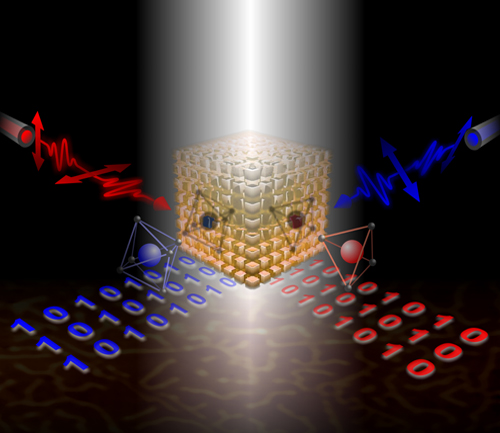
- A. Stupakiewicz, K. Szerenos, D. Afanasiev, A. Kirilyuk, A.V. Kimel, “Ultrafast nonthermal photo-magnetic recording in a transparent medium”, Nature 542, 71 (2017).
- A. Stupakiewicz, K. Szerenos, M. D. Davydova, K. A. Zvezdin, A. K. Zvezdin, A. Kirilyuk, A. V. Kimel, “Selection rules for all-optical magnetic recording in iron garnet”, Nature Comm. 10, 612 (2019).
Dynamic complex opto-magnetic holography
Holography recreates both the amplitude and wave front of a three dimensional object, meaning that the observer perceives the image in the nearly same way as they would the true object. Creating such holographic images is challenging computationally, and requires extremely fast display update. Here, we demonstrate combine a fast memoryless computation algorithm with the ultrafast writing based on all-optical magnetization switching in a ferrimagnetic film [3].
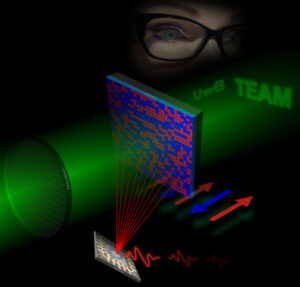
3. M. Makowski, J. Bomba, A. Frej, M. Kolodziejczyk, M. Sypek, T. Shimobaba, T. Ito, A. Kirilyuk, A. Stupakiewicz, “Dynamic complex opto-magnetic holography”, Nature Comm. 13, 7286 (2022).
Magneto-optical experimental techniques:
-
-
- High sensitivity magneto-optical Kerr magnetometry
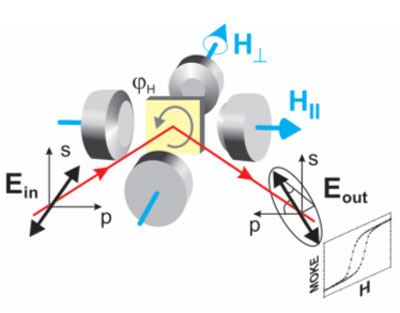
- High sensitivity magneto-optical Kerr magnetometry
-
Magneto-optical Kerr (MOKE) magnetometer equipped with special electro-magnets system (perpendicular to the plane sample up to 20 kOe and in-plane up to 4kOe magnetic field), Coherent Ar (Innova 300) and red-diode lasers, optical cryostat (10-650K), photo-elastic modulator (s,p-polarization, rotation and ellipticity polar, longitudinal, transverse Kerr effects, linear and circular dichroism). Study of static and dynamics magnetization reversal processes and vector magnetization analysis in ultrathin multilayer magnetic films with specialized LabView software for control magnetometer and data analysis.
-
-
- Magnetization-sensitive second harmonic generation
-
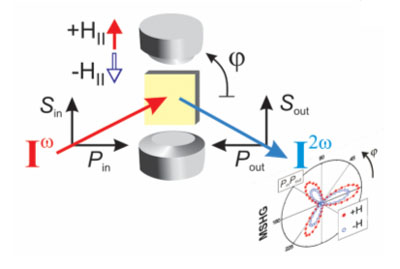
The magnetization-sensitive optical second-harmonic generation (MSHG) measurements were performed using a modelocked Ti-sapphire (Spectra-Physics) femtosecond laser operating in the 690–1040 nm range. The pulse width of the laser was 150 fs and the repetition rate 80 MHz. The SHG signal was measured using a photomultiplier after a special filtering to reject the fundamental wavelength. We applied an in-plane magnetic field in the transverse magneto-optical configuration which saturates the in-plane magnetization. The MSHG intensity measurements were done in the following four input-output polarization combinations: PinPout, SinPout, PinSout, and SinSout, varying the azimuthal in-plane rotation angle of the sample around the surface-normal direction, and for each direction of the applied magnetic field. Such sets of measurements thus allowed to separate the crystallographic and magnetic contributions to the total signal.
-
-
- Ultrafast magneto-optical pump-probe
-
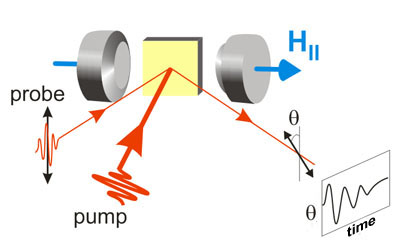
Ultrafast magnetization dynamics were performed using femtosecond (35 fs) pulses of wavelength 290-2500 nm emitted from amplifier system (Ace Spectra-Physics, Astrella Coherent) at a repetition rate of 1 kHz were split into two parts using a beam splitter. The most intense part (pump) was incident on the sample at near normal incidence. The magnetization dynamics induced by these pump pulses was followed in time by measuring the Kerr or Faraday rotation of the time delayed and much weaker probe pulses (pump/probe~ 100) as function of the variable pump-probe separation t. The rotation angle is proportional to the projection of the magnetization vector along the wave vector of the probe light.
